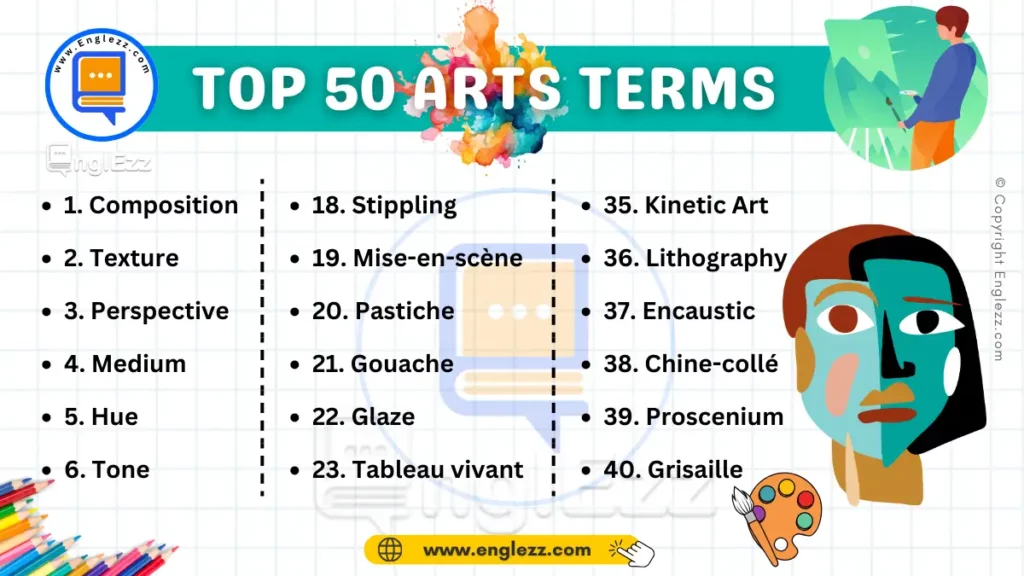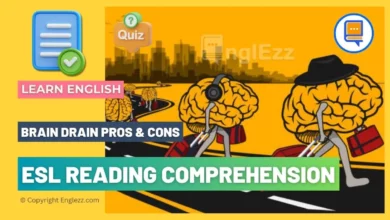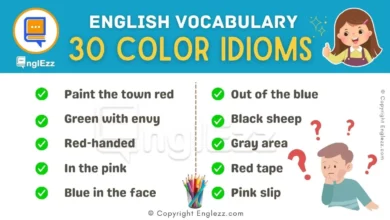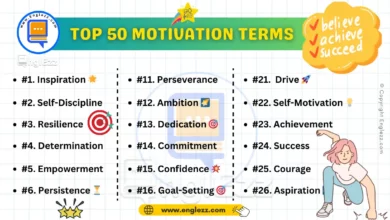From the basics of visual arts to the nuances of performing arts, this article covers a wide range of terms that will help you navigate discussions about art with confidence. This comprehensive guide delves into the 50 most frequently used arts terms, providing clear explanations and practical examples to enhance your artistic vocabulary.
Each term is accompanied by its phonetic transcription, ensuring proper pronunciation, and two illustrative examples to demonstrate its usage in context. Whether you’re analyzing a painting, discussing a theatrical performance, or exploring the intricacies of sculpture, this resource will serve as your go-to reference for arts terminology.
Table of Contents
- 50 Most Common Arts English Terms Explained with Examples
- #1. 🎨 Composition /ˌkɒmpəˈzɪʃən/
- #2. 🖌️ Texture /ˈtekstʃər/
- #3. 🎭 Perspective /pəˈspektɪv/
- #4. 🖼️ Medium /ˈmiːdiəm/
- #5. 🎨 Hue /hjuː/
- #6. 🖌️ Tone /təʊn/
- #7. 🎭 Gesture /ˈdʒestʃər/
- #8. 🖼️ Contrast /ˈkɒntrɑːst/
- #9. 🎨 Palette /ˈpælət/
- #10. 🖌️ Symmetry /ˈsɪmətri/
- #11. 🎭 Rhythm /ˈrɪðəm/
- #12. 🖼️ Negative Space /ˈneɡətɪv speɪs/
- #13. 🎨 Abstraction /æbˈstrækʃən/
- #14. 🖌️ Chiaroscuro /kɪˌɑːrəˈskjʊərəʊ/
- #15. 🎭 Motif /məʊˈtiːf/
- #16. 🖼️ Juxtaposition /ˌdʒʌkstəpəˈzɪʃən/
- #17. 🎨 Saturation /ˌsætʃəˈreɪʃən/
- #18. 🖌️ Impasto /ɪmˈpæstəʊ/
- #19. 🎭 Foreshortening /fɔːˈʃɔːtnɪŋ/
- #20. 🖼️ Sfumato /sfuːˈmɑːtəʊ/
- #21. 🎨 Trompe l’oeil /trɒmp ˈlɔɪ/
- #22. 🖌️ Pentimento /ˌpentɪˈmentəʊ/
- #23. 🎭 Assemblage /əˈsembllɪdʒ/
- #24. 🖼️ Chroma /ˈkrəʊmə/
- #25. 🎨 Fresco /ˈfreskəʊ/
- #26. 🖌️ Stippling /ˈstɪplɪŋ/
- #27. 🎭 Mise-en-scène /miːz ɒn sen/
- #28. 🖼️ Pastiche /pæˈstiːʃ/
- #29. 🎨 Gouache /ɡwɑːʃ/
- #30. 🖌️ Glaze /ɡleɪz/
- #31. 🎭 Tableau vivant /tæbˌləʊ viːˈvɒn/
- #32. 🖼️ Triptych /ˈtrɪptɪk/
- #33. 🎨 Monochrome /ˈmɒnəkrəʊm/
- #34. 🖌️ Vignette /vɪnˈjet/
- #35. 🎭 Kinetic Art /kɪˈnetɪk ɑːt/
- #36. 🖼️ Lithography /lɪˈθɒɡrəfi/
- #37. 🎨 Encaustic /ɪnˈkɔːstɪk/
- #38. 🖌️ Chine-collé /ʃiːn kɒˈleɪ/
- #39. 🎭 Proscenium /prəˈsiːniəm/
- #40. 🖼️ Grisaille /ɡrɪˈzaɪ/
- #41. 🎨 Pointillism /ˈpɔɪntɪlɪzəm/
- #42. 🖌️ Sgraffito /zɡræˈfiːtəʊ/
- #43. 🎭 Blocking /ˈblɒkɪŋ/
- #44. 🖼️ Trompe l’oeil /trɒmp ˈlɔɪ/
- #45. 🎨 Underpainting /ˈʌndəpeɪntɪŋ/
- #46. 🖌️ Bas-relief /bɑː rɪˈliːf/
- #47. 🎭 Proscenium /prəˈsiːniəm/
- #48. 🖼️ Bricolage /ˌbriːkəˈlɑːʒ/
- #49. 🎨 Sfumato /sfuːˈmɑːtəʊ/
- #50. 🖌️ Tenebrism /ˈtenəbrɪzəm/
- Medical English Terms Table
- Conclusion
50 Most Common Arts English Terms Explained with Examples
In the vibrant world of arts, language plays a crucial role in expressing ideas, techniques, and emotions. Whether you’re an aspiring artist, a passionate art enthusiast, or simply curious about the terminology used in various artistic disciplines, understanding common arts English terms is essential.
Embark on this linguistic journey through the arts, and discover how mastering these terms can deepen your appreciation and understanding of various artistic expressions. Let’s dive into the colorful world of arts vocabulary and unlock the power of effective communication in the realm of creativity.
#1. 🎨 Composition /ˌkɒmpəˈzɪʃən/
Definition: The arrangement of elements within a work of art.
Examples:
- The composition of the painting balanced the light and dark areas effectively.
- In photography, the rule of thirds is a popular guideline for creating pleasing compositions.
#2. 🖌️ Texture /ˈtekstʃər/
Definition: The surface quality of an artwork, either actual (tactile) or implied (visual).
Examples:
- The artist used impasto technique to create a rich, textured surface on the canvas.
- The smooth texture of the marble sculpture contrasted with the rough stone base.
#3. 🎭 Perspective /pəˈspektɪv/
Definition: The technique of representing three-dimensional objects on a two-dimensional surface.
Examples:
- The Renaissance painter mastered linear perspective to create depth in the cityscape.
- In this drawing, atmospheric perspective makes distant mountains appear hazy and less detailed.
#4. 🖼️ Medium /ˈmiːdiəm/
Definition: The material or technique used to create an artwork.
Examples:
- Oil paint was the preferred medium of many Old Masters.
- The sculptor experimented with various media, including bronze, wood, and stone.
#5. 🎨 Hue /hjuː/
Definition: The pure state of a color, determined by its dominant wavelength.
Examples:
- The artist used a vibrant blue hue to capture the intensity of the ocean.
- By mixing different hues, the painter created a complex and nuanced color palette.
#6. 🖌️ Tone /təʊn/
Definition: The lightness or darkness of a color.
Examples:
- The charcoal drawing relied on a range of tones to create depth and form.
- In this landscape painting, the artist used subtle tonal variations to suggest atmospheric conditions.
#7. 🎭 Gesture /ˈdʒestʃər/
Definition: A quick, expressive drawing or movement that captures the essence of a subject.
Examples:
- The life drawing class began with rapid gesture sketches to warm up.
- The dancer’s fluid gestures conveyed the emotion of the choreography.
#8. 🖼️ Contrast /ˈkɒntrɑːst/
Definition: The difference between elements in an artwork, often used to create visual interest.
Examples:
- The stark contrast between light and shadow in Caravaggio’s paintings creates dramatic effects.
- The graphic designer used color contrast to make the text stand out against the background.
#9. 🎨 Palette /ˈpælət/
Definition: The range of colors used by an artist in a particular work or style.
Examples:
- Monet’s palette often included soft, pastel hues to capture the effects of light.
- The fashion designer’s autumn collection featured a warm, earthy palette.
#10. 🖌️ Symmetry /ˈsɪmətri/
Definition: The balanced arrangement of elements on either side of a central axis.
Examples:
- The Taj Mahal is renowned for its perfect symmetry in architectural design.
- The butterfly’s wings demonstrate bilateral symmetry in nature.
#11. 🎭 Rhythm /ˈrɪðəm/
Definition: The repetition or alternation of elements to create visual movement or pattern.
Examples:
- The abstract painting used repeating shapes to create a sense of rhythm and flow.
- In architecture, the rhythmic placement of windows along the facade added visual interest.
#12. 🖼️ Negative Space /ˈneɡətɪv speɪs/
Definition: The empty or unoccupied areas in an artwork that contribute to the overall composition.
Examples:
- The logo design cleverly used negative space to create a hidden image.
- In this minimalist sculpture, the negative space is as important as the solid forms.
#13. 🎨 Abstraction /æbˈstrækʃən/
Definition: The process of simplifying or distorting representational forms to create non-realistic art.
Examples:
- Kandinsky’s paintings moved towards pure abstraction, focusing on color and form.
- The sculptor abstracted the human figure to its most basic geometric shapes.

#14. 🖌️ Chiaroscuro /kɪˌɑːrəˈskjʊərəʊ/
Definition: The use of strong contrasts between light and dark to create a sense of volume in painting.
Examples:
- Rembrandt’s portraits are famous for their dramatic use of chiaroscuro.
- The film noir genre often employs chiaroscuro lighting techniques for atmospheric effect.
#15. 🎭 Motif /məʊˈtiːf/
Definition: A recurring element, pattern, or theme in an artwork or across an artist’s body of work.
Examples:
- Water lilies became a central motif in Monet’s later paintings.
- The Art Nouveau movement often incorporated natural motifs like flowers and vines.
#16. 🖼️ Juxtaposition /ˌdʒʌkstəpəˈzɪʃən/
Definition: The placement of elements side by side, often to create contrast or new meaning.
Examples:
- The collage artist juxtaposed images from different time periods to comment on social change.
- In this installation, the juxtaposition of organic and industrial materials created tension.
#17. 🎨 Saturation /ˌsætʃəˈreɪʃən/
Definition: The intensity or purity of a color.
Examples:
- The digital artist increased the saturation to make the sunset colors more vivid.
- Fauvism is characterized by the use of highly saturated colors.
#18. 🖌️ Impasto /ɪmˈpæstəʊ/
Definition: A technique of applying paint thickly to create texture and dimensionality.
Examples:
- Van Gogh’s impasto technique gives his paintings a tactile, three-dimensional quality.
- The contemporary artist used heavy impasto to create abstract landscapes with physical depth.
#19. 🎭 Foreshortening /fɔːˈʃɔːtnɪŋ/
Definition: The technique of depicting an object or figure as if it extends back in space.
Examples:
- Michelangelo’s ceiling frescoes in the Sistine Chapel demonstrate masterful foreshortening.
- The comic book artist used extreme foreshortening to make the superhero appear to leap off the page.
#20. 🖼️ Sfumato /sfuːˈmɑːtəʊ/
Definition: A painting technique that softens outlines and blends tones to create a hazy effect.
Examples:
- Leonardo da Vinci’s “Mona Lisa” is famous for its subtle use of sfumato.
- The contemporary painter employed sfumato to evoke a dreamy, ethereal atmosphere.
#21. 🎨 Trompe l’oeil /trɒmp ˈlɔɪ/
Definition: A style of painting that creates the illusion of three-dimensional objects or spaces.
Examples:
- The mural artist used trompe l’oeil techniques to paint a convincing fake window on the wall.
- The still life painting featured trompe l’oeil elements that fooled the eye into seeing real objects.
#22. 🖌️ Pentimento /ˌpentɪˈmentəʊ/
Definition: An underlying image or element in a painting that shows through, revealing the artist’s changes.
Examples:
- X-ray analysis revealed several pentimenti in the old master painting, showing the artist’s evolving composition.
- The visible pentimento in the portrait gave insight into the artist’s creative process.
#23. 🎭 Assemblage /əˈsembllɪdʒ/
Definition: A three-dimensional artwork created by combining found objects.
Examples:
- The artist’s assemblage incorporated discarded machine parts to comment on industrialization.
- Rauschenberg’s “Combines” are famous examples of assemblage in modern art.
#24. 🖼️ Chroma /ˈkrəʊmə/
Definition: The purity or intensity of a color, similar to saturation.
Examples:
- The artist used high-chroma colors to create a vibrant, eye-catching poster design.
- In color theory, understanding chroma helps artists create more nuanced color palettes.
#25. 🎨 Fresco /ˈfreskəʊ/
Definition: A technique of painting on freshly laid, wet plaster.
Examples:
- Michelangelo’s frescoes in the Sistine Chapel are among the most famous examples of this technique.
- Contemporary artists have revived the fresco technique for public murals.
#26. 🖌️ Stippling /ˈstɪplɪŋ/
Definition: A drawing or painting technique using small dots to create tone and texture.
Examples:
- The illustrator used stippling to create subtle shading in the black and white portrait.
- In printmaking, stippling can produce delicate gradations of tone.
#27. 🎭 Mise-en-scène /miːz ɒn sen/
Definition: The arrangement of scenery and props on a stage for a theatrical production.
Examples:
- The director’s innovative mise-en-scène transformed the minimalist set into a dynamic space.
- In film, mise-en-scène includes all visual elements that contribute to the mood and meaning of a shot.
#28. 🖼️ Pastiche /pæˈstiːʃ/
Definition: An artwork that imitates the style of another artist or period.
Examples:
- The contemporary painting was a clever pastiche of Renaissance portraiture.
- Postmodern architecture often incorporates pastiche elements from various historical styles.
#29. 🎨 Gouache /ɡwɑːʃ/
Definition: An opaque watercolor paint that produces a matte finish.
Examples:
- The illustrator preferred gouache for its vibrant colors and smooth coverage.
- Matisse often used gouache to create his famous paper cut-outs.
#30. 🖌️ Glaze /ɡleɪz/
Definition: A thin, transparent layer of paint applied over a dry underpainting.
Examples:
- The Old Masters used multiple glazes to build up rich, luminous color.
- In ceramics, glazes are used to add color, texture, and protection to pottery.
#31. 🎭 Tableau vivant /tæbˌləʊ viːˈvɒn/
Definition: A silent and motionless group of people arranged to represent a scene or incident.
Examples:
- The performance art piece included a series of tableaux vivants inspired by famous paintings.
- Historical reenactments often use tableaux vivants to bring pivotal moments to life.
#32. 🖼️ Triptych /ˈtrɪptɪk/
Definition: An artwork consisting of three panels or sections, typically hinged together.
Examples:
- The altarpiece was a triptych depicting scenes from the life of Christ.
- The contemporary photographer presented a triptych of urban landscapes to show the passage of time.
#33. 🎨 Monochrome /ˈmɒnəkrəʊm/
Definition: An artwork created using only one color or hue.
Examples:
- The artist’s series of monochrome blue paintings explored the depth and variation within a single hue.
- Black and white photography is a classic form of monochrome imagery.
#34. 🖌️ Vignette /vɪnˈjet/
Definition: A small illustration or decorative design, often found on a book’s title page.
Examples:
- The graphic novel used vignettes to break up the main panels and add visual interest.
- In photography, a vignette effect darkens the edges of an image to draw focus to the center.
#35. 🎭 Kinetic Art /kɪˈnetɪk ɑːt/
Definition: Art that incorporates movement as a key element.
Examples:
- Calder’s mobiles are iconic examples of kinetic sculpture.
- The interactive installation used motorized elements to create constantly changing kinetic art.
#36. 🖼️ Lithography /lɪˈθɒɡrəfi/
Definition: A printing process based on the repulsion of oil and water.
Examples:
- Toulouse-Lautrec’s posters are famous examples of lithographic art.
- Modern lithography techniques are used in mass production of printed materials.
#37. 🎨 Encaustic /ɪnˈkɔːstɪk/
Definition: A painting technique using heated beeswax mixed with colored pigments.
Examples:
- Ancient Egyptian mummy portraits were often created using encaustic techniques.
- Contemporary artists have revived encaustic painting for its unique textural qualities.
#38. 🖌️ Chine-collé /ʃiːn kɒˈleɪ/
Definition: A printmaking technique that involves adhering thin paper to a heavier support during the printing process.
Examples:
- The artist used chine-collé to incorporate delicate Japanese paper into their etching.
- Chine-collé allows printmakers to introduce color and texture into monochromatic prints.
#39. 🎭 Proscenium /prəˈsiːniəm/
Definition: The part of a theater stage in front of the curtain.
Examples:
- The traditional proscenium arch framed the stage, creating a clear separation between actors and audience.
- Modern theater designs often challenge the conventions of the proscenium stage.
#40. 🖼️ Grisaille /ɡrɪˈzaɪ/
Definition: A painting technique using shades of gray or another neutral color.
Examples:
- Medieval stained glass often incorporated grisaille panels to modulate light.
- The artist used grisaille as an underpainting before adding layers of color glazes.
#41. 🎨 Pointillism /ˈpɔɪntɪlɪzəm/
Definition: A painting technique using small, distinct dots of color to form an image.
Examples:
- Seurat’s “A Sunday Afternoon on the Island of La Grande Jatte” is a famous example of pointillism.
- Digital artists sometimes emulate pointillism techniques to create textured illustrations.
#42. 🖌️ Sgraffito /zɡræˈfiːtəʊ/
Definition: A decorative technique of scratching through a surface to reveal a lower layer of contrasting color.
Examples:
- The ceramic artist used sgraffito to create intricate patterns on the pottery surface.
- In fresco painting, sgraffito can be used to add fine details to the wet plaster.
#43. 🎭 Blocking /ˈblɒkɪŋ/
Definition: The positioning and movement of actors on a stage or set.
Examples:
- The director spent the first week of rehearsals focusing on blocking to ensure smooth scene transitions.
- In film, careful blocking helps create dynamic compositions within each shot.
#44. 🖼️ Trompe l’oeil /trɒmp ˈlɔɪ/
Definition: A style of painting that creates the illusion of three-dimensional objects or spaces.
Examples:
- The mural artist used trompe l’oeil techniques to paint a convincing fake window on the wall.
- The still life painting featured trompe l’oeil elements that fooled the eye into seeing real objects.
#45. 🎨 Underpainting /ˈʌndəpeɪntɪŋ/
Definition: The initial layer of paint applied to a canvas, often monochromatic, which serves as a base for subsequent layers.
Examples:
- The artist used a warm sienna underpainting to give the portrait a golden glow.
- Verdaccio, a greenish-gray underpainting, was commonly used in Renaissance paintings.
#46. 🖌️ Bas-relief /bɑː rɪˈliːf/
Definition: A sculptural technique where the design projects slightly from the background.
Examples:
- Ancient Egyptian hieroglyphs often appear in bas-relief on temple walls.
- The modern sculptor created a bas-relief panel depicting urban life for a public building.
#47. 🎭 Proscenium /prəˈsiːniəm/
Definition: The part of a theater stage in front of the curtain.
Examples:
- The traditional proscenium arch framed the stage, creating a clear separation between actors and audience.
- Modern theater designs often challenge the conventions of the proscenium stage.
#48. 🖼️ Bricolage /ˌbriːkəˈlɑːʒ/
Definition: Art created from a diverse range of available materials.
Examples:
- The installation artist used bricolage techniques, incorporating found objects from urban environments.
- In fashion, bricolage can involve combining unexpected materials and styles to create unique garments.
#49. 🎨 Sfumato /sfuːˈmɑːtəʊ/
Definition: A painting technique that softens outlines and blends tones to create a hazy effect.
Examples:
- Leonardo da Vinci’s “Mona Lisa” is famous for its subtle use of sfumato.
- The contemporary painter employed sfumato to evoke a dreamy, ethereal atmosphere.
#50. 🖌️ Tenebrism /ˈtenəbrɪzəm/
Definition: A dramatic form of chiaroscuro where violent contrasts of light and dark are used for emphasis.
Examples:
- Caravaggio’s paintings are renowned for their use of tenebrism to create dramatic, theatrical effects.
- The film noir genre often employs tenebristic lighting to create a moody, suspenseful atmosphere.
Mastering these 50 common arts English terms opens up a world of nuanced understanding and appreciation for the visual and performing arts. From the foundational elements of composition and perspective to specialized techniques like sfumato and tenebrism, this vocabulary empowers you to engage more deeply with artworks across various mediums and periods.
Medical English Terms Table
| 1. Composition | 18. Stippling | 35. Kinetic Art |
| 2. Texture | 19. Mise-en-scène | 36. Lithography |
| 3. Perspective | 20. Pastiche | 37. Encaustic |
| 4. Medium | 21. Gouache | 38. Chine-collé |
| 5. Hue | 22. Glaze | 39. Proscenium |
| 6. Tone | 23. Tableau vivant | 40. Grisaille |
| 7. Gesture | 24. Triptych | 41. Pointillism |
| 8. Contrast | 25. Monochrome | 42. Sgraffito |
| 9. Palette | 26. Vignette | 43. Blocking |
| 10. Symmetry | 27. Impasto | 44. Trompe l’oeil |
| 11. Rhythm | 28. Foreshortening | 45. Underpainting |
| 12. Negative Space | 29. Sfumato | 46. Bas-relief |
| 13. Abstraction | 30. Chiaroscuro | 47. Bricolage |
| 14. Motif | 31. Pentimento | 48. Tenebrism |
| 15. Juxtaposition | 32. Assemblage | 49. Fresco |
| 16. Saturation | 33. Chroma | 50. Collage |
| 17. Trompe l’oeil | 34. Fresco |
Conclusion
By familiarizing yourself with these terms, you’ll be better equipped to analyze, discuss, and even create art with greater confidence and precision. Whether you’re a student, an art enthusiast, or a practicing artist, this knowledge will enhance your ability to communicate about art effectively and to perceive the subtle intricacies that make each artwork unique.
Remember that art is a constantly evolving field, and while these terms provide a solid foundation, the language of art continues to expand and adapt. As you explore different artistic movements and contemporary practices, you’ll encounter new terminologies that build upon these basics. Keep your curiosity alive, and don’t hesitate to delve deeper into the fascinating world of art theory and criticism.
Armed with this enhanced vocabulary, you’re now ready to embark on a richer journey through galleries, museums, theaters, and the vast landscape of human creativity.
Let these terms be your guide as you explore the diverse and inspiring realm of the arts, always remembering that at its core, art is about expression, emotion, and the endless possibilities of human imagination.








